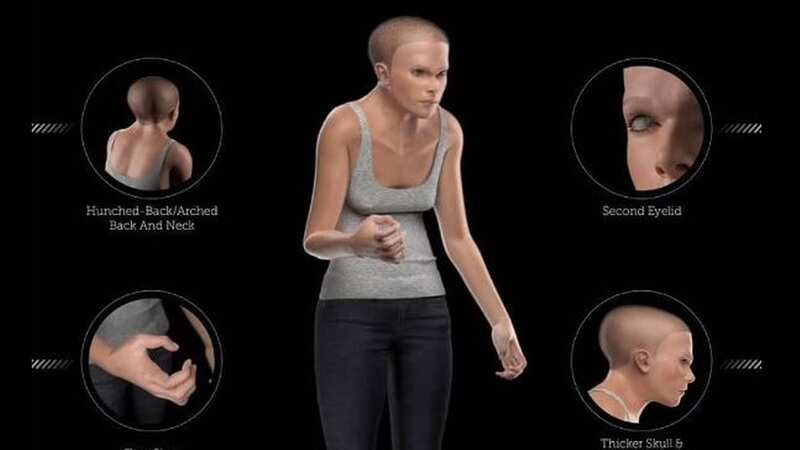Disturbing image of how humans could evolve - second eyelid, claw and tech neck

We're all guilty of looking down at our smartphones a little too much - whether it's for scrolling social media, texting on WhatsApp, or online shopping. But it's not just the small screen captivating our attention amid technology advancements, as a large proportion of workers now work at a desk all day staring at a desktop.
According to a survey from Fellowes, the majority (81 percent) of UK office workers spend between four and nine hours each day sitting at their desks, which equates to an average of 67 sedentary days per person each year. It is well-documented that sitting in one position for a lengthy period of time is unhealthy, however, researchers have now put it into perspective - painting a horrifying picture of what they predict the reality could look like.
They created 'Mindy', a model of what humans could evolve into by the year 3000. With a thicker neck, a hunched-over posture, and a smaller brain - it's a mortifying glimpse into the future that could be awaiting mankind if the predictions made by Toll Free Forwarding are correct.
 The future looks terrifying (Toll Free Forwarding)
The future looks terrifying (Toll Free Forwarding)What do you think about technology? Let us know in the comments...
A spokesperson said: "Technology has revolutionised the way we do business. Whether it's the instant access to infinite knowledge through a device in our pocket, or the ability for businesses to expand into new markets all over the world with a virtual phone number, the scope of technology's impact is limitless, and this trend shows no sign of letting up.
 Viral sausage roll debate leaves Brits confused about how to order at Greggs
Viral sausage roll debate leaves Brits confused about how to order at Greggs
"While this has been great for job creation, productivity, and learning new skills, there is a growing body of evidence that uncovers the negative effects technology can have on our bodies. To fully realise the impact everyday tech has on us, we sourced scientific research and expert opinion on the subject, before working with a 3D designer to create a future human whose body has physically changed due to consistent use of smartphones, laptops, and other tech." On their website, the experts explained each of the evolutionary changes that we could face.
 Our elbows could be stuck at 90 degree angles, better for holding phones (Toll Free Forwarding)
Our elbows could be stuck at 90 degree angles, better for holding phones (Toll Free Forwarding)Arched Back and Neck
They said: "The design and typical user habits of modern tech objects like smartphones and computer monitors have a significant impact on the way we sit and stand. Consistently adjusting our position to look down at our phone, or up at our office screen, has been proven to strain parts of our body that determine our posture."
Text Claw
They continued: "A closer look at Mindy's arm reveals two significant anatomical changes, directly caused by the use of one particular tech device – the smartphone. A recently coined condition, 'text claw' occurs after consistently gripping your smartphone, curling your fingers round into an unnatural position for long periods of time."
90-Degree Elbow
They added: "Also known as 'smartphone elbow', this is caused by the typical positioning of the arm when holding and using smartphones – either for general use or holding up to our ears during phone calls."
 Are you guilty of this? (stock image) (Getty Images/iStockphoto)
Are you guilty of this? (stock image) (Getty Images/iStockphoto)Tech Neck
They wrote: "Returning to Mindy's posture, the effects of technology on the neck have also given rise to a new condition – aptly named 'tech neck'."
Thicker Skull
 Drink-driver steals JCB digger to smash into family house in revenge attack
Drink-driver steals JCB digger to smash into family house in revenge attack
They said: "We all know technology can distract our brains from important work, but does it have any lasting damage to Mindy's brain? "If so, how might she be different when looking to limit that damage? Again, the research centres mainly around smartphones. There are growing concerns that radiofrequency radiation emitted from smartphones could cause serious health implications when exposed to the brain."
Smaller Brain
They added: "The next change to Mindy's appearance isn't noticeable to the naked eye. We may develop thicker skulls, but if one scientific theory is to be believed, technology may also change the size of our brains."
A Second Eyelid
They continued: "Mindy's final change is possibly her most outlandish. "One area we're yet to touch on is the eyes. Research into screens causing headaches, eye strain, and even blindness is well established – so how does Mindy’s body look to combat this?
"We spoke to Kasun Ratnayake from the University of Toledo, who suggested a radical evolutionary development that could limit the amount of harmful light our eyes are exposed to." Kasun said: "Humans may develop a larger inner eyelid to prevent exposure to excessive light, or the lens of the eye may be evolutionarily developed such that it blocks incoming blue light but not other high wavelength lights like green, yellow or red."
Read more similar news:
Comments:
comments powered by Disqus

































